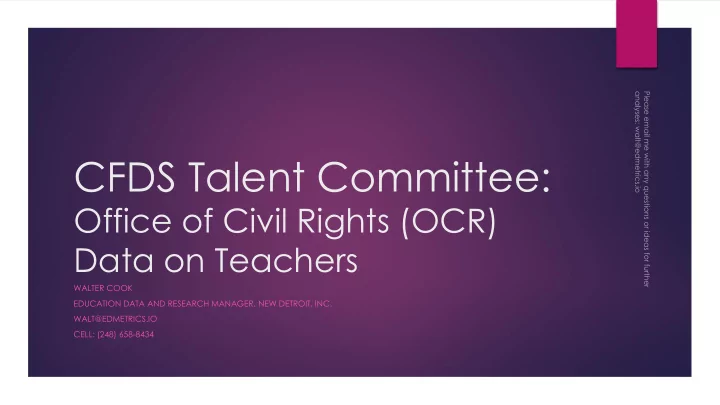

CFDS Talent Committee: Office of Civil Rights (OCR) Data on Teachers WALTER COOK EDUCATION DATA AND RESEARCH MANAGER, NEW DETROIT, INC. WALT@EDMETRICS.IO CELL: (248) 658-8434
Objectives of This Presentation Provide a brief overview of the Office of Civil Rights (OCR) data on teachers and how it may be helpful to this Committee OCR data can address some questions that public use state-level data cannot However, there are limitations to what the OCR dataset can Generate additional questions that the OCR dataset might be able to answer Please email me with any questions or ideas for further analyses: walt@edmetrics.io
Brief Overview of the OCR Data Set Biannual survey from the US Department of Education’s Office of Civil Rights (OCR) to all public schools in the US Variables include a number of building-level measures not available in CEPI datasets (including several related to teachers) Main drawback is that is only published biannually with a two year lag (i.e., 2013-14 most recent available; 2015-16 to be published June 2018) Most measures of interest only available from 2009-10, 2011-12, 2013-14 We have had limited access to the dataset for a few days, so this presentation probably just scratches the surface of how this dataset could be leveraged Please email me with any questions or ideas for further analyses: walt@edmetrics.io
Limitations of OCR Data Set Everything is self-reported by the district/school and is not regularly audited Some values are obviously misreported (e.g., lists average teacher salary at Cass Tech in 2011-12 as $154k) Some inconsistencies with CEPI data with respect to counts for teachers and students Where OCR data conflict with CEPI data, CEPI is probably more reliable Does not provide individual-level data, only building-level averages Some questions relevant to this Committee would be better investigated using individual-level data, but that is not presently available to us Please email me with any questions or ideas for further analyses: walt@edmetrics.io
CEPI Data on Teachers Is Limited to Building-Level Averages and in Scope
OCR Data Provides Greater Insights
Some Findings From Sector Analysis Less experienced teachers much more likely to teach in Charters over 25% of charter school teachers in Detroit were in their first or second year of teaching in 2013-14, compared to less than 10% of DPS relatedly, seniority within a traditional salary schedule is almost certainly driving the higher DPS salaries relative to EAA and Charters Teacher Chronic Absenteeism much more of a problem than DPS or EAA (if taken at face value — not sure I believe EAA had zero such teachers) Chronic absenteeism at K-8 Charter much higher than HS Charters One surprising finding is that across all sectors the average compensation for High School teachers is lower than K-8 Greater variation among Charter schools in terms of average teacher salaries note: many of the K-12 Charters are specialty schools (e.g., Blanche Kelso) and average teacher salaries driven by staff all being special education Please email me with any questions or ideas for further analyses: walt@edmetrics.io
Recommend
More recommend